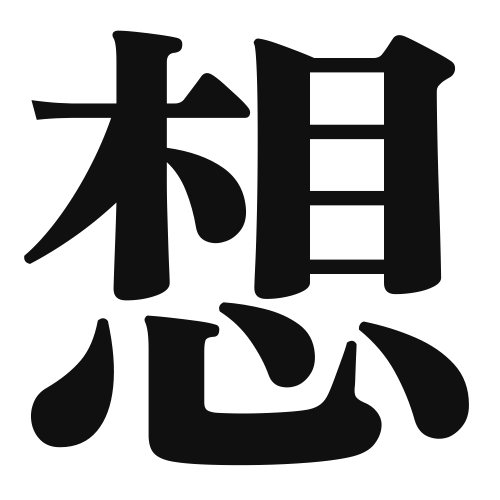1. Overview of Meaning
The kanji “想” (sō) means “to think,” “to imagine,” or “to consider.” It conveys the idea of mental activity, reflecting one’s thoughts or feelings about something.
2. Formation and Radicals
The kanji “想” is composed of two parts: the radical “心” (kokoro), which means “heart” or “mind,” and the phonetic component “相” (sō), which contributes to its pronunciation. This kanji is classified as a 形声文字 (keisei moji), meaning it combines meaning and sound elements.
3. Examples of Usage
Common words and phrases that include “想” are:
- 想像 (sōzō) – imagination
- 思考 (shikō) – thinking
- 感想 (kansō) – impression or thoughts
Example sentences in daily conversation:
- 私はその映画についての感想を話しました。
(Watashi wa sono eiga ni tsuite no kansō o hanashimashita.)
“I shared my thoughts about that movie.” - 彼は未来を想像するのが得意です。
(Kare wa mirai o sōzō suru no ga tokui desu.)
“He is good at imagining the future.”
4. Synonyms and Antonyms
Similar kanji with related meanings include:
- 思 (shi) – to think, which emphasizes the act of thinking rather than the imaginative aspect.
- 考 (kō) – to consider or contemplate, which often implies a more analytical approach.
Antonyms include:
- 忘 (waki) – to forget, which represents the opposite of remembering or thinking about something.
5. Cultural and Historical Background
The kanji “想” is deeply rooted in Japanese culture, often associated with the importance of reflection and imagination in various art forms, such as literature and painting. It appears in many proverbs and idiomatic expressions, such as:
- 想い出 (omoide) – memories, which emphasizes the act of recalling past thoughts and feelings.
- 想像力 (sōzōryoku) – creativity or imagination, highlighting the value placed on imaginative thinking in Japanese society.
